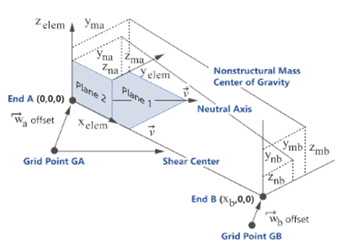Orient Bar2 or Bar3 Elements
Use the Edit Beam: Orient tool to define bar2 or bar3 orientation.
Each solver profile manages beam orientation in a different way and provides more or less flexibility to define orientation, such as vector or third node. However, despite such variability in the way solver realizes orientation, the context options remain almost unchanged and hide the complexity. However, if an option is irrelevant for a given solver, it will be hidden.

Figure 1. OptiStruct Solver Bar2 Orientation
Although HyperMesh has a Global system (system ID=0), some solvers (for example, OptiStruct/Nastran) use global to denote the node's output system and use Basic to refer to laboratory global system. Basic and Displacement are used for the laboratory reference system or the node output system in which displacement components are written.
- The orientation direction defines the XY planes. Hence, whenever orientation is set along shell normal, theY-axis matches with shell positive normal as a result.
- All orientation methods, but picking reference node result on X,Y,Z orientation vector, are saved at element level.
- Using the Orientation by Vector tool (with or without system) will assign the OFFT key for orient as B. This means components are expressed in Basic system, see Figure 3.
- Using Orientation in displacement system will set OFFT for orientation as G, see Figure 3.
- Replace Orient by vector is available.
- The orientation direction defines the XZ planes. Hence, whenever orientation is set along shell normal, the Z-axis matches with shell positive normal as a result.
- All orientation methods result in the creation or update of a third node on each bar2/bar3. Hence, there is no concern of Basic/Displacement system.
- Replace Orient by vector is not available as it is meaningless.

Figure 3.
